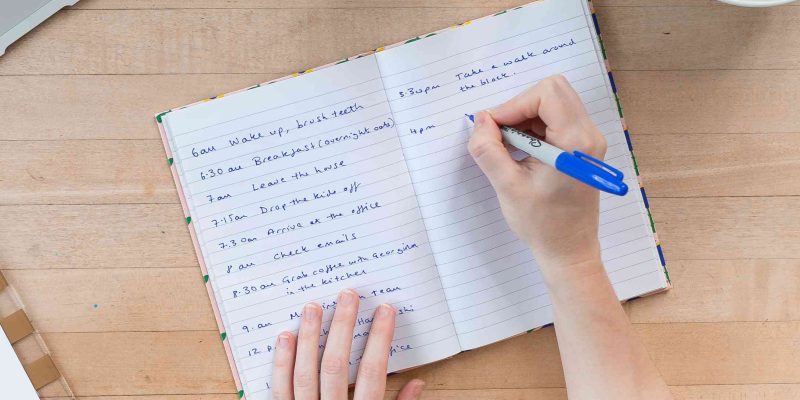Let’s face it, we all have busy lives.
There’s 5 days of work, and of course taking the kids to school. Then there is all the cooking, cleaning and washing you have to do too.
Not to mention exercising, and catching up with friends, your socials and of course your favourite TV shows!
Then, there is the little matter of quality ‘couple time’ too.
It’s no wonder you struggle to get everything done!
But when you think about it, that really shouldn’t be the case. After all there are 24 hours in a day. Which equates to 1440 minutes. Or 86,400 seconds overall.
So really that is more than enough time to get yourself organised.
And therein lies the key – being organised.
To get everything you need doing in a day completed, all you really need is to organise your routine in a way that makes it fun and productive.
In this article, we will show you how to do just that.
How to be more organised
When it comes to being more organised, the hardest part is finding, and sticking, to a daily routine that works for you.
This can take some time, and really depends on your attitude, lifestyle, time-management skills and what works best for you.
To devise a suitable routine, you will need to be honest with yourself about your personality and abilities. But here is what you can do.
Make a List
First things first, you should write down all the tasks you need to complete in the day. You can divide this into ‘work’ and ‘home’ tasks.
At this stage, you don’t need to worry about trying to organise the list in some strategic order. Simply just see this exercise as a brainstorm that highlights all the things you need to do.
Whether you need to take the bins out, wash the clothes, pay a few bills, or search for a birthday present for your nephew, try and write down as many things as you can remember.
Be sure to have the list on hand too, just in case something comes back to you later in the day.
Begin to structure your day
When faced with a long list of tasks you need to complete, the next thing you should do is begin to structure your day by creating a ‘To-do List’.
A great way to do this is to divide your day into different sections – morning, midday, afternoon and evening.
Depending on if you are an early bird that wakes up and hits the ground running, or a night owl that is more productive in the evening, try and think about when you work most efficiently.
Having established this, then you can start to group your tasks within the various time sections.
Mornings
Generally, the main focus of mornings is about getting out of the door on time – particularly if you also need to go to work, as well as drop the kids off at school.
Therefore, it is worth grouping similar tasks together that take place in, or around, the same room. Such as making breakfast, wiping down the kitchen bench, or taking the clean dishes out of the dishwasher.
If you organise yourself properly, you can even apply the ‘two-minute rule’ to several tasks before you leave. This involves you doing a bunch of jobs that take less than two minutes each – like taking the bins out and putting the dirty clothes in the laundry.
This way, in just 20 minutes you could tick 10 tasks off your to-do-list. So, all of a sudden, you don’t have as much left to do. (The same principle applies at the office too).
For the rest of the morning, you can then focus on the most pressing or crucial tasks you need to do.
Midday
If you have had a busy morning, then the time around midday can be a bit of a slog. Particularly if your energy levels have dwindled and you are in need of lunch.
As a result, it might be a good idea to schedule in those mundane tasks you can do without thinking.
In the office this might be filing, replying to emails or making appointments. While at home it could be cleaning the bathroom, mopping the floors or hoovering the house. Here are some tips on how to clean the house quickly.
Afternoon
The few hours after lunch before the school pick up, or your time to leave work, should be used for trying to finish off the most important items on your daily ‘To-do list’ you still have outstanding.
This is a time to try and be most productive as it can often be the last time in the day when you are ‘free’ to complete these activities.
Evenings
Evenings should generally be about planning and preparing for the following day.
Although you might be a little tired, try and organise your clothes for work, and the kids’ school uniforms. Make the packed lunches in advance and, if need be, even have a shower before you go to bed. This will save you time the next morning.
Be specific to certain timeframes
If you need that extra bit of a push, you could even set specific timeframes in which to complete the tasks.
This might include:
6.30 am: Wake up & shower
7 am: Have breakfast
7.15 am: Take bins out
7:20 am: Unpack the dishwasher
While this level of details might not be for everyone, if you tick off every item on your ‘To-do List’ as you complete them, you will see the progress you have made.
You will also appreciate how much time is left in the day to complete your other tasks.
Multi-task
When it comes to being productive the key thing is to be able to multitask. That way you can get more done.
It sounds simple enough, but don’t get caught in the trap of doing things strictly in order on your list, and only after one task has been completed.
For instance, only washing the clothes in the machine after you have washed up all the dishes. Instead, use your time more productively by doing tasks concurrently.
In other words, put the washing on first in the machine, and then whilst you are waiting for the cycle to finish, wash the dishes. That way they will be done by the time the washing is ready to be hung up.
Despite being the most obvious and logical way to go about things, it is amazing how many people don’t do this!
Be flexible
One of the most important things to do when creating a routine is to set aside some free time.
As well as affording you time to rest and relax, the main benefit of doing this is that it gives you flexibility with your routine.
Therefore, if anything pops up, such as an unexpected visitor, or the need for a doctor’s appointment, you will still have time to complete the tasks on your ‘to-do list’ afterwards.
Similarly, if you are feeling super motivated, or not very motivated at all, you can swap your tasks around accordingly to accommodate this mood – while still getting some things on your ‘to-do list’ done.
Looking for time saving solutions
Throughout the week you do a lot of the same tasks every day e.g., cooking and cleaning. So, it is always worth looking for time saving solutions.
Whether this involves batch cooking at the weekend, which you can then heat up during the week, having someone like Gathar prepare meals for you, or even hiring the services of a cleaner, this could be something that could save you a lot of time.
Add fun into the routine!
One of the best ways to ensure you create a daily routine that works for you, is to make it fun!
Whilst the tasks themselves might be a bit mundane you can always make them a lot more enjoyable.
For instance, sing along to your favourite Spotify playlist when you are cleaning the bathroom. Chat to a friend on the phone when you take the dog for a walk. Use a timer and try and ‘beat the clock’ when it comes to hanging up the washing – you can even give yourself a reward of a chocolate or cheeky wine if you succeed!
Doing this can make your daily routine much more entertaining.
Test out your new routine
Creating a new daily routine is one thing, but actually ensuring it works for you is another thing entirely.
Therefore, it is important to test it out for a good couple of weeks at least, to make sure you have got it right.
During this time, try and stick to the routine as much as you can – although feel free to finetune it.
Ultimately you want to get to a situation where you can operate like clockwork. Ensuring that all tasks are completely proficiently and smoothly every day, without taking up too much of your time.














Comments